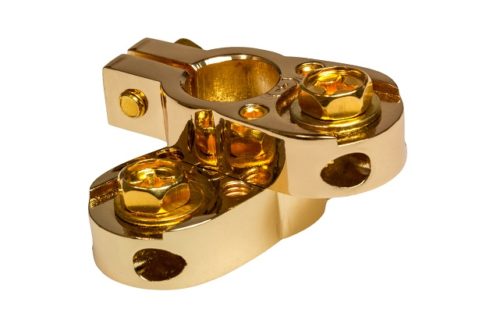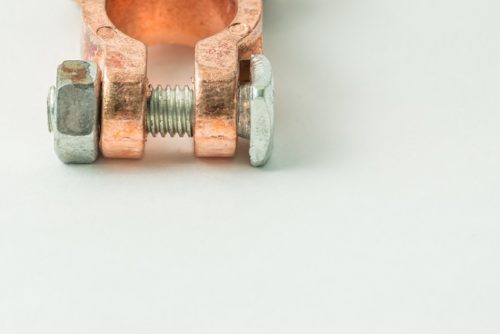The Advantages of Using Gold-Plated Electrical Contacts
1 Comment
Electrical contacts are essential electronic circuit components in any device that controls the flow of electricity. Primarily found in circuit breakers, relays, connectors, and switches, contacts open and close the electrical circuit running through the device. When contacts are connected, the circuit is “closed” and able to carry current. Conversely, when contacts are separated by an insulating air gap, the circuit is “open” and interrupted.
Many standard and custom electrical contacts are comprised of conductive metals, such as nickel, copper, cadmium, and other various alloys. Although these materials are capable, they can and do degrade over time due to oxidation, corrosion, erosion, and heat. For this reason, many manufacturers apply a thin layer of gold plating with a nickel undercoating to protect their contacts and improve their capabilities.
Why Use Gold Plating?
You’re probably wondering why electrical contact manufacturers use gold plating; after all, the precious metal is expensive. However, gold has various physical and chemical properties that make it ideal for electronic applications. Here are some that make it a solid long-term return on investment.
- Better corrosion protection: Gold boasts an incredible resistance to oxidation, which produces corrosion; this makes it ideal for contacts exposed to corrosive environments or agents.
- Improved electrical conductivity: Corrosive environments and agents degrade metals commonly used in contacts, thus interfering with their conductivity. Gold doesn’t break down under these conditions and protects the contacts from corrosion and rust.
- Increased durability: Gold provides considerable protection from regular wear and tear like fretting, which is erosion caused by repeated rubbing and friction; this can considerably prolong a contact’s lifespan.
- Ease of application: An electrical contact requires just a very thin layer of plating—any excess coating will negatively inhibit its efficiency. Gold is an incredibly malleable metal, making it very simple to apply the proper amount of plating for each unique application.
- Excellent heat resistance: Gold’s properties make it a valid form of protection for contacts routinely exposed to high temperatures (>125°C/257°F).
How Powder Metallurgy Contact Tips Beat Conventional Fabrication
2 Comments
When you have raw metals that you need turned into usable pieces, you have a few fabrication options. There are a lot of conventional techniques that get the job done. For instance, you may have your finished good machined from semi-finished casing products. However, these days, powder metallurgy applications are far more efficient for a variety of reasons, and they can help save your company money while getting the best possible products. Here are just a few reasons why powder metallurgy contact tips are more beneficial than the alternatives.
Accuracy
Since powder metallurgy manufacturers have a higher degree of accuracy than manufacturers of most other forms of fabrication, that means you can get repeatable results when you need products of the same size and dimension. When it comes to small components like contact tips, it’s especially important that everything is just the right shape and size. It’s also a factor to consider if you have any special requirements needed to make them most effective. For instance, you might need to change the porosity of the metal or alter it so that it has a lower melting point in order for your contact tips to perform well as they’re intended.
Material Expense
Powder metallurgy materials are often cheaper to buy than semi-finished materials. That means you’re starting off at a lower base price for purchasing powder metallurgy contact tips than when purchasing other types. This is because you can find raw materials more easily and because less work went into preparing them.
Production Expense
Because of the process accuracy, it’s easier to mass produce contact tips with powder metallurgy applications. That means that you can buy them in bulk, which often gets you company discounts. The production also process produces very little waste, which means you’re not spending on extras, and it’s a more sustainable option.
Overall, powder metallurgy contact tips provide heightened performance at a lower bottom dollar cost, which is music to the ears of manufacturers everywhere.
Copper versus Aluminum Electrical Contacts: A Comparison
1 Comment
The differences between copper and aluminum contacts is probably not a topic at a dinner party, well, anywhere. It is, however, foremost on the minds of those who build electrical equipment, appliances, machinery and systems or if the person in question is an aluminum and copper extrusion supplier. To those people, the differences are critical to making sure whatever they are working on is a success. Here is a comparison of the two types of contacts and where each has the best application.
Weight
Aluminum weighs less than copper. Comparatively, it weighs much less. That makes it ideal for applications where overall weight is a factor. For example, aluminum is used in electric transmission and distribution lines because the lighter weight means fewer support towers are needed. In fact, most high-voltage wires are made of aluminum. The weight factor only plays a role with contacts many are used in the application or project. With space and footprint being a critical focus under most project management methodologies, aluminum or custom copper extrusions focused on weight reduction might be the preferred choice.
Carry Capacity
Aluminum carries about half of the current potential as copper. As such, copper is the better choice if the consideration is only electrical capacity per volume. Aluminum, however, carries more electricity if the key metric is capacity based on weight. Again, a copper extrusion manufacturer might be able to shed weight in the production process, but overall, aluminum is lighter, but has to handle a lighter load.
Practically, what all that means is that copper will be more resilient as a connector material, but aluminum offers less carry capacity, but could be the preferred choice if weight is the deciding factor. In applications where weight is of extreme importance, say in aviation, thousands of aluminum connectors versus the same in copper could make a defining difference. An example of when copper would make more sense is when the load the connector would be carrying was heavier than what an aluminum connector could carry if all other things were equal.
Longevity and Maintenance
It stands to reason that here again, load capacity is a deciding factor. If an aluminum connector will wear out quicker if exposed to a heavier load or if affected by dust, dirt and debris and change-out of components was an issue, copper is your better choice. If maintenance is not an issue or if the application has a high burn rate and thus the connector reliability does not matter, aluminum might be the better choice.
There are many factors that help determine if copper or aluminum connectors is the better option. Weight, load capacity and maintenance all factor in what you choose from your aluminum and copper extrusion supplier.
Expert Tips to Increase the Life of Your Switchgear Contacts
Leave a Comment Your electric power system puts up with a lot of stress. If you’ve had the same system in your building for a while, then it’s important for you to routinely examine it and maintain it as necessary. Otherwise, you could end up having to replace part or all of the system, which is not only a huge expense, but is also a time-consuming project that can seriously inconvenience you until it’s all finished. A big part of your maintenance should involve your switching equipment, especially your switchgear auxiliary contacts.
Your electric power system puts up with a lot of stress. If you’ve had the same system in your building for a while, then it’s important for you to routinely examine it and maintain it as necessary. Otherwise, you could end up having to replace part or all of the system, which is not only a huge expense, but is also a time-consuming project that can seriously inconvenience you until it’s all finished. A big part of your maintenance should involve your switching equipment, especially your switchgear auxiliary contacts.
Perform Inspections
Since you’re dealing with complex electrical systems and may not have the equipment or expertise to do it yourself, you may want to hire contact switchgear services to perform regular inspections. Whether you do it yourself or hire someone, this inspection should not only include a cursory visual inspection but also a more in-depth infrared inspection. This helps you find you find the loose connections that could cause problems later. When you perform these inspections, you may have to recondition old parts or even replace parts on occasion if they’re too damaged to use anymore. This may seem like a waste of money, but investing a little now can save you money later, since one damaged part can cause a series of problems throughout the system if left untreated.
Keep It Clean
As with most things, switchgear contacts perform best when clean. This means you should remove dirt, dust, and any other contaminants that might build up in the system. The contacts are exposed to a lot of moisture and heat as well as microscopic debris, so you should clean the contacts as necessary and protect them from further contamination as much as possible.
Exercise Your Breakers
One way to help keep your contacts clean is to exercise your breakers. Professional contact switchgear services can help you with this part, in case you’re worried about messing around with your system and potentially damaging something. Essentially, they will open the circuit breakers manually to keep everything moving freely and prevent any corrosive buildup that might interfere with the system. Ideally, this should be done once a year.
